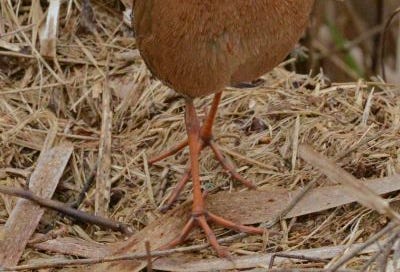April: The Virginia Rail
They are frequently described as shy, secretive, and rarely seen: meet the solitary, slender Virginia rail.
Virginia rails are, as their name suggests, “thin as a rail,” at least when you look at them head on. From the side, they look to have wider, fuller bodies. Their laterally compressed body shapes and flexible vertebrae allow them to move easily among dense bulrushes and cattails in the marshes where they live. They occupy freshwater wetlands across much of the United States and far southern Canada. While some Virginia rails are permanent residents, others do migrate to southern portions of the United States, Mexico, and sometimes even as far south as Guatemala in the winter; in southern areas, they tend to live in coastal saltmarshes.
Virginia rails are overall a dusty rust color, with gray cheeks, black-and-white barring on the sides, and white feathers under their short, upturned tail. They have tough forehead feathers, which protect their heads as they nuzzle their way through dense marsh plants. The Virginia rail’s slightly curved bill is long, thin, and reddish. Likewise, its legs and toes are long, thin, and a reddish color. Their powerful legs aid Virginia rails in walking on soft mud; the rail species has the greatest leg-to-flight muscle ratio of any other bird. So, while they do fly and can swim, navigating by foot through muddy reeds is what they are built for.
Indeed, Virginia rails may be happier than pigs in mud; they seek out shallow water with muddy bottoms to forage for water insects, slugs, snails, frogs, crayfish, earthworms, and small fish. In winter, they will also eat plants and seeds. They typically search food at dawn and dusk; birders often look for them during these low-light hours.
In the spring, seasonally monogamous pairs of Virginia rails weave basket-like nests with canopies together out of wetland vegetation, which rest on or slightly above the waterline. They typically weave more than one nest; these extra nests they place near their real nest to act as “dummy nests” to distract predators.
Spring is the season when these birds are most vocal; their calls have been described as a “ticket ticket” or “kiddick kiddick” sound. Pairs make “grunting duets”—a sound not unlike an oink—to defend their territories. So if your springtime strolls take you near wetlands, you may much admire the sight of grebes and ducks, but be sure to take a careful listen for the Virginia rail—its sound is the only evidence you may ever get of its presence.
Sources:
https://www.allaboutbirds.org/guide/Virginia_Rail/overview
https://www.audubon.org/field-guide/bird/virginia-rail
https://ebird.org/species/virrai
https://www.birdweb.org/birdweb/bird/virginia_rail



